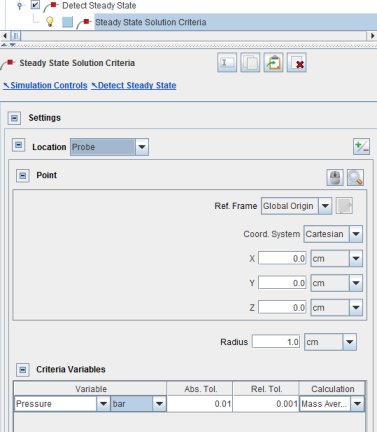After selecting the Detect Steady State option, the
simulation will determine a steady-state condition based on a set of Solution
Criteria
 . Multiple Solution Criteria can be created under the Detect
Steady State option. The simulation reaches a steady state if ALL specified criteria
are satisfied within a monitoring time interval.
. Multiple Solution Criteria can be created under the Detect
Steady State option. The simulation reaches a steady state if ALL specified criteria
are satisfied within a monitoring time interval.
A solution criterion can be specified at three types of locations: Entire Domain, Probe, or Open Boundary.
Entire Domain: A set of user-specified solution variables are monitored in fluid cells or vertices within the entire domain. The solution variables are selected and assigned both an absolute and a relative tolerance, as well as a calculation option. Available calculation options are Maximum Value and Mass Averaging.
Probe: This option is similar to the Entire Domain option, but the solution variables are monitored within a spherical probe, which can be specified using a Point (center) and a Radius.
Open Boundary: When a system reaches a steady state, the net mass flow rate across all the open boundaries should approach zero. In this option, a normalized net mass flow rate is monitored for steady state detection. The flow throughput of the system is used as the normalization factor to make the normalized net flow rate dimensionless. The normalized net mass flow rate is defined as:
where and
are the mass flow rates summed over all inlets and all outlets, respectively.
For all these mass flow rate terms, the sign is positive if the flow goes into the computational
domain, and vice versa. This option also requires absolute and relative tolerances for the
convergence check.
For each monitored solution variable, S, the absolute and relative
solution differences are calculated for each time step using a direct variable differencing
method. To avoid detecting fake steady states, the convergence check uses solution differences
averaged over a time interval (the default and recommended value is 0.1 ms) instead of the
instantaneous values. The convergence check criteria can be written as:
where is the total number of time steps accumulated within 0.1 ms before the current
time.
To claim a steady state, BOTH absolute and relative criteria need to be satisfied. The Open-Boundary-based criterion requires an additional check. The normalized net mass flow rate needs to satisfy the absolute tolerance as well, that is,
The instantaneous solution values, absolute differences, and relative differences are printed in .csv files named solution_vector_(criterion name).csv, solution_absdiff_(criterion name), solution_reldiff_(criterion name), respectively. The limiting convergence constraint together with its absolute and relative solution differences are also printed in FORTE.log and MONITOR for each time step. You should remember that the printed solution differences are instantaneous values, while the values used for the convergence check are based on multiple instantaneous values accumulated within a time interval.
Steady-state simulations are restricted such that they do not allow the specification of moving boundaries, transient temperature or pressure inlets, transient pressure outlets, or transient wall temperatures. Spray injections are allowed, but only if the mass flow and parcel count options are continuous, not pulsed.
Steady-state simulations are restricted such that they do not allow the specification of moving boundaries, transient temperature or pressure inlets, transient pressure outlets, or transient wall temperatures. Spray injections are allowed, but only if the mass flow and parcel count options are continuous, not pulsed.



